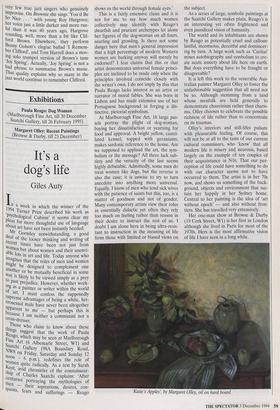Exhibitions
Paula Reago: Dog Woman (Marlborough Fine Art, till 30 December Saatchi Gallery, till 26 February 1995)
It's a dog's life
Giles Auty
In a week in which the winner of the 1994 Turner Prize described his work as Psychological Cubism' it seems clear my Pleas for more thoughtful use of language about art have not been instantly heeded. Mr Gormley notwithstanding, a good deal of the looser thinking and writing of recent times have been not just from Women but about women and their unenvi- able lots in art and life. Today anyone who Imagines that the roles of men and women might be designed to complement one another or be mutually beneficial in some way is likely to be viewed simply as a prey to past prejudice. However, whether work- ing as a painter or writer within the world of art, I must confess the supposedly s°Preme advantages of being a white, het- erosexual male have never been altogether apparent to me — but perhaps this is because I am neither a communist nor a cross-dresser.
Those who claim to know about these things suggest that the work of Paula Reago, which may be seen at Marlborough Fine Art (6 Albemarle Street, W1) and
Saatchi Gallery (98A Boundary Road, 1\11A/8 on Friday, Saturday and Sunday 12 noon – 6 p.m.), redefines the role of Women quite radically. As a text by Sarah Kent, avid chronicler of the connoisseur- ship of Charles Saatchi explains: 'After centuries portraying the mythologies of men — their aspirations, desires, con- quests, fears and sufferings — Reago shows us the world through female eyes.'
This is a fairly extensive claim and it is not for me to say how much women collectively may identify with Reago's dwarfish and prurient archetypes let alone her figures of the dog-woman on all fours, snarling and growling. Is there not some danger here that men's general impression that a high percentage of modern Western women are barking anyway will merely be endorsed? I fear claims that this or that artist demonstrates universal female princi- ples are inclined to be made only when the principles involved coincide closely with the writer's own. I do not imply by this that Paula Reago lacks interest as an artist or narrator of moral fables. She was born in Lisbon and has made extensive use of her Portuguese background in forging a dis- tinctive, pictorial symbolism.
At Marlborough Fine Art, 16 large pas- tels portray the plight of dog-woman, baying her dissatisfaction or yearning for food and approval. A bright yellow, castel- lated kennel, topped with geraniums, makes sardonic reference to the home. Are we supposed to applaud the art, the sym- bolism or the message? All three lack sub- tlety and the veracity of the last seems highly debatable. Admittedly, some men do treat women like dogs, but the reverse is also the case; it is unwise to try to turn anecdote into anything more universal. Equally, 1 know of men who tend sick wives with the patience of saints but this, too, is a matter of goodness and not of gender. Many contemporary artists view their roles as essentially didactic yet often they rely too much on feeling rather than reason in their desire to instruct the rest of us. I doubt I am alone here in being ultra-resis- tant to instruction in the meaning of life from those with limited or biased views on the subject.
As a series of large, symbolic paintings at the Saatchi Gallery makes plain, Reago's is an interesting yet often frightened and even jaundiced vision of humanity.
The world and its inhabitants are shown by Reago as potentially cruel and callous: lustful, incestuous, deceitful and domineer- ing by turn. A large work such as 'Caritas' mixes autobiography and symbolism to cre- ate acute anxiety about life here on earth. But does everything have to be fraught or disagreeable?
It is left this week to the venerable Aus- tralian painter Margaret 011ey to foster the unfashionable suggestion that all need not be so. Although stemming from a land whose menfolk are held generally to demonstrate chauvinism rather than charis- ma, 011ey chooses to celebrate the possible richness of life rather than to concentrate on its traumas.
011ey's interiors and still-lifes pulsate with pleasurable feeling. Of course, this will not be at all to the taste of our current cultural commissars, who 'know' that all modern life is misery and neurosis, based largely on the example of ten couples of their acquaintance in N16. That our per- ception of life could have something to do with our character seems not to have occurred to them. The artist is in her 70s now, and shows us something of the back- ground, objects and environment that sus- tain her happily in her Sydney home. Central to her painting is the idea of 'art without epoch' — and also without fron- tiers. She has travelled very extensively.
Her one-man show at Browse & Darby (19 Cork Street, W1) is her first in London although she lived in Paris for most of the 1970s. Hers is the most affirmative vision of life I have seen in a long while.
'Katie's Apples', by Margaret 011ey, oil on hard board










































































 Previous page
Previous page